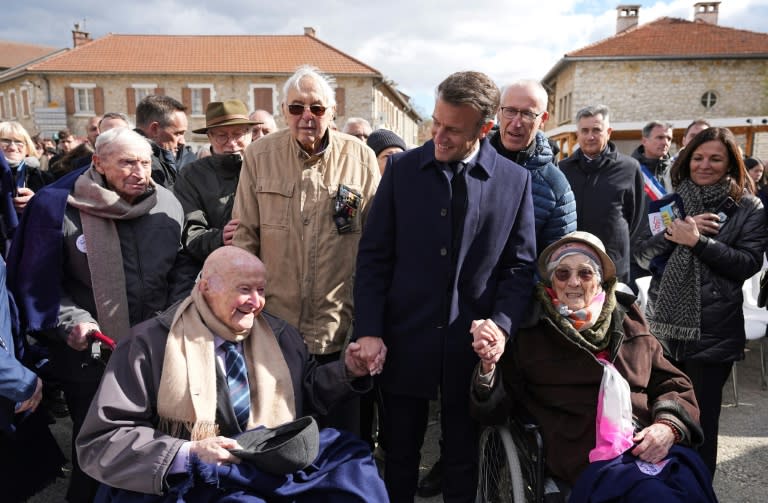Macron recalls dark side of French WWII history in resistance tribute

- Oops!Something went wrong.Please try again later.
President Emmanuel Macron on Tuesday hailed the heroism of members of the World War II Resistance based on a remote Alpine plateau, but also remembered the "errors" of French collaborationist forces who sided with the Germans against them.
The Resistance used the Vercors Plateau as a refuge after the occupation of France from 1940, receiving airdrops from the Allies and even occasional visits by British agents with the top-secret Special Operations Executive unit.
With 2024 marking eight decades since the penultimate year of World War II, Macron is making a series of high-profile commemorations to remember Resistance heroes but also to note the role played by French collaborationist militia in the German occupation.
"Here 80 years ago French people killed other French people," Macron said in the village of Vassieux-en-Vercors.
It was the first such commemoration in the village by a French president.
Conspicuously he had chosen to visit on April 16 -- the date marking 80 years since the French militia attacked the Resistance holdout -- rather than July 21 when German army forces launched a full-scale assault.
"Let us also remember these French people, their choices and errors," Macron said, referring to the collaborators.
"Because it was not just a time when French people did not love each other. It was also a time when some French people did not love France," he said.
- 'Didn't want to be invaded' -
Resistance members began to gather on the Vercors plateau from 1942 and came to number some 4,000 people.
They were mostly French but also included about 50 Senegalese infantrymen and 30 Polish teenagers, a presidential adviser said.
Rene Heren, 97, was one of those who took part in sabotage operations against the Germans.
"We didn't want our country to be invaded," said the former Resistance fighter, who was 17 years old at the time.
He also helped ferry the wounded to a field hospital in a nearby town, which saved his life when the Germans attacked.
The French militia's attack on April 16, 1944 did not end the activities of the Resistance on the plateau, with the Allies seeing it as potentially crucial to the landings in northern and southern France later that year.
Resistance members in early July even declared the Free Republic of Vercors, seen today as linked to the modern French republic.
- 'Where hatred leads' -
But the German army attack, involving some 10,000 soldiers, in July wiped that out, destroying 570 houses and killing 840 people -- Resistance fighters and civilians.
Those killed included 73 villagers.
"They were aged 18 months to 91 years old", the village mayor Thomas Ottenheimer said in the main square, in front of a monument to those who lost their lives.
Their names engraved in stone show "where hatred leads", he said.
The July attack was the biggest operation by the Wehrmacht against Resistance fighters in western Europe during World War II.
It came just weeks before the Allied landings in southern France and the liberation of the area from German control.
This year's commemorations peak in June with the 80th anniversary of the 1944 Normandy landings. A host of world leaders are expected to attend, including US President Joe Biden.
Russian representatives would also be invited to "honour the importance of the commitment and sacrifices of the Soviet peoples" during the war, but President Vladimir Putin would not, organisers said on Tuesday.
In August, France will mark the liberation of Paris from Nazi occupation.
bur-fff/ah/bp

